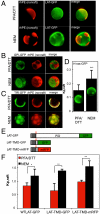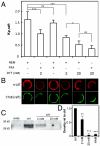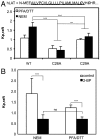Palmitoylation regulates raft affinity for the majority of integral raft proteins
- PMID: 21131568
- PMCID: PMC3009825
- DOI: 10.1073/pnas.1016184107
Palmitoylation regulates raft affinity for the majority of integral raft proteins
Abstract
The physical basis for protein partitioning into lipid rafts remains an outstanding question in membrane biology that has previously been addressed only through indirect techniques involving differential solubilization by nonionic detergents. We have used giant plasma membrane vesicles, a plasma membrane model system that phase separates to include an ordered phase enriching for raft constituents, to measure the partitioning of the transmembrane linker for activation of T cells (LAT). LAT enrichment in the raft phase was dependent on palmitoylation at two juxtamembrane cysteines and could be enhanced by oligomerization. This palmitoylation requirement was also shown to regulate raft phase association for the majority of integral raft proteins. Because cysteine palmitoylation is the only lipid modification that has been shown to be reversibly regulated, our data suggest a role for palmitoylation as a dynamic raft targeting mechanism for transmembrane proteins.
Conflict of interest statement
The authors declare no conflict of interest.
Figures





Similar articles
-
Membrane raft association is a determinant of plasma membrane localization.Proc Natl Acad Sci U S A. 2014 Jun 10;111(23):8500-5. doi: 10.1073/pnas.1404582111. Epub 2014 May 27. Proc Natl Acad Sci U S A. 2014. PMID: 24912166 Free PMC article.
-
Palmitoylation of LAT contributes to its subcellular localization and stability.Biochem Biophys Res Commun. 2006 Mar 24;341(4):1177-83. doi: 10.1016/j.bbrc.2006.01.076. Epub 2006 Jan 27. Biochem Biophys Res Commun. 2006. PMID: 16460687
-
Palmitoylation-dependent plasma membrane transport but lipid raft-independent signaling by linker for activation of T cells.J Immunol. 2009 Aug 1;183(3):1685-94. doi: 10.4049/jimmunol.0803921. Epub 2009 Jul 10. J Immunol. 2009. PMID: 19592663 Free PMC article.
-
Greasing their way: lipid modifications determine protein association with membrane rafts.Biochemistry. 2010 Aug 3;49(30):6305-16. doi: 10.1021/bi100882y. Biochemistry. 2010. PMID: 20583817 Review.
-
Structural determinants of protein partitioning into ordered membrane domains and lipid rafts.Chem Phys Lipids. 2015 Nov;192:23-32. doi: 10.1016/j.chemphyslip.2015.07.022. Epub 2015 Aug 1. Chem Phys Lipids. 2015. PMID: 26241883 Review.
Cited by
-
The C99 domain of the amyloid precursor protein resides in the disordered membrane phase.J Biol Chem. 2021 Jan-Jun;296:100652. doi: 10.1016/j.jbc.2021.100652. Epub 2021 Apr 9. J Biol Chem. 2021. PMID: 33839158 Free PMC article.
-
Monitoring lipid anchor organization in cell membranes by PIE-FCCS.J Am Chem Soc. 2012 Jul 4;134(26):10833-42. doi: 10.1021/ja300374c. Epub 2012 Jun 14. J Am Chem Soc. 2012. PMID: 22631607 Free PMC article.
-
Biomimetic Lipid Raft: Domain Stability and Interaction with Physiologically Active Molecules.Adv Exp Med Biol. 2024;1461:15-32. doi: 10.1007/978-981-97-4584-5_2. Adv Exp Med Biol. 2024. PMID: 39289271 Review.
-
Generating Giant Membrane Vesicles from Live Cells with Preserved Cellular Properties.Research (Wash D C). 2019 Jun 17;2019:6523970. doi: 10.34133/2019/6523970. eCollection 2019. Research (Wash D C). 2019. PMID: 31549076 Free PMC article.
-
Folding and Misfolding of Human Membrane Proteins in Health and Disease: From Single Molecules to Cellular Proteostasis.Chem Rev. 2019 May 8;119(9):5537-5606. doi: 10.1021/acs.chemrev.8b00532. Epub 2019 Jan 4. Chem Rev. 2019. PMID: 30608666 Free PMC article.
References
-
- Resh MD. Palmitoylation of ligands, receptors, and intracellular signaling molecules. Sci STKE. 2006;2006:re14. - PubMed
-
- Melkonian KA, Ostermeyer AG, Chen JZ, Roth MG, Brown DA. Role of lipid modifications in targeting proteins to detergent-resistant membrane rafts. Many raft proteins are acylated, while few are prenylated. J Biol Chem. 1999;274:3910–3917. - PubMed
-
- Moffett S, Brown DA, Linder ME. Lipid-dependent targeting of G proteins into rafts. J Biol Chem. 2000;275:2191–2198. - PubMed
-
- Rocks O, et al. An acylation cycle regulates localization and activity of palmitoylated Ras isoforms. Science. 2005;307:1746–1752. - PubMed
-
- Webb Y, Hermida-Matsumoto L, Resh MD. Inhibition of protein palmitoylation, raft localization, and T cell signaling by 2-bromopalmitate and polyunsaturated fatty acids. J Biol Chem. 2000;275:261–270. - PubMed
Publication types
MeSH terms
Substances
LinkOut - more resources
Full Text Sources
Other Literature Sources
Molecular Biology Databases
Research Materials

